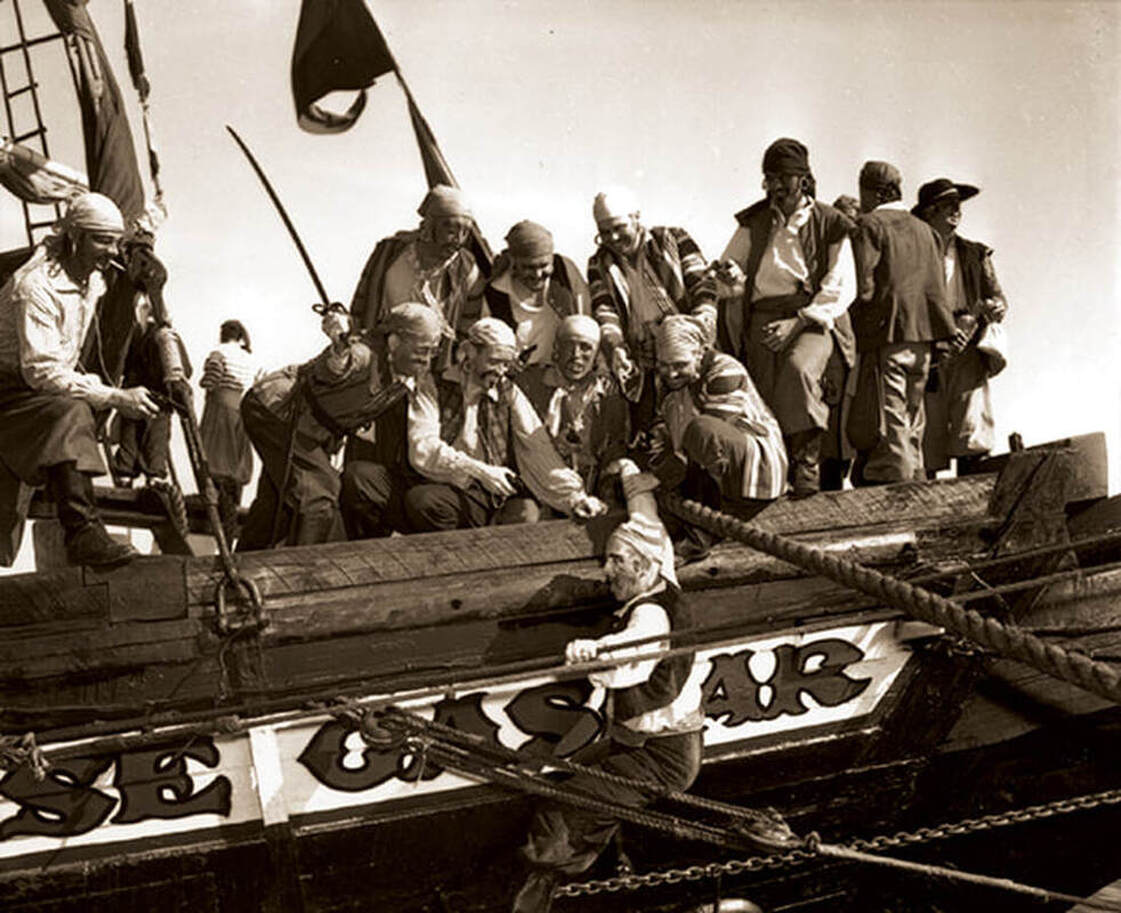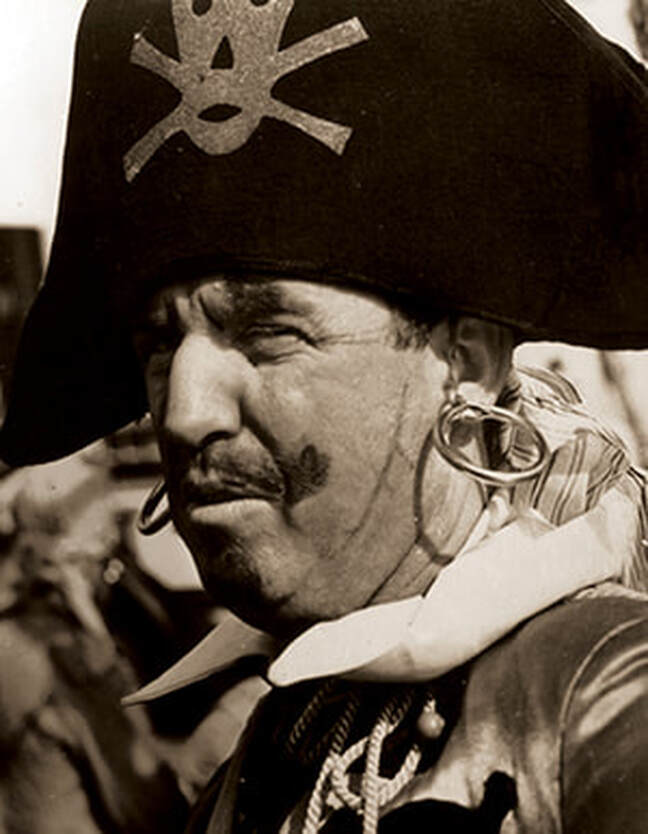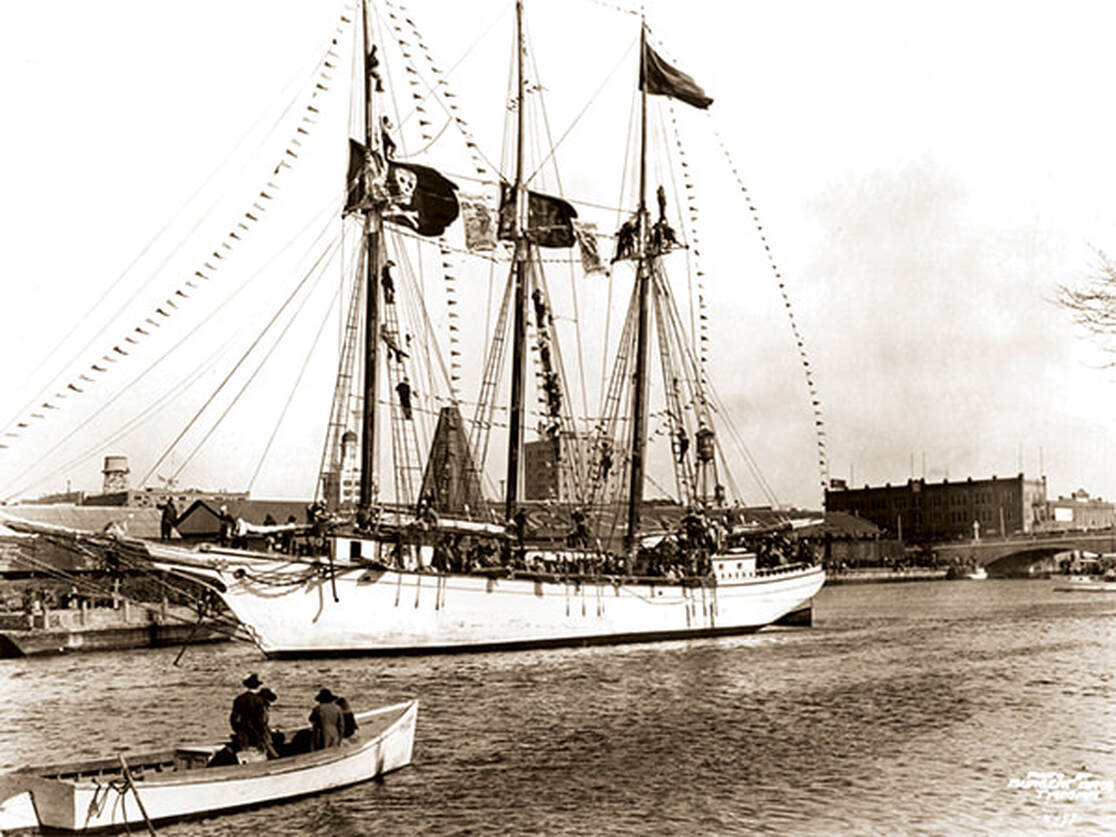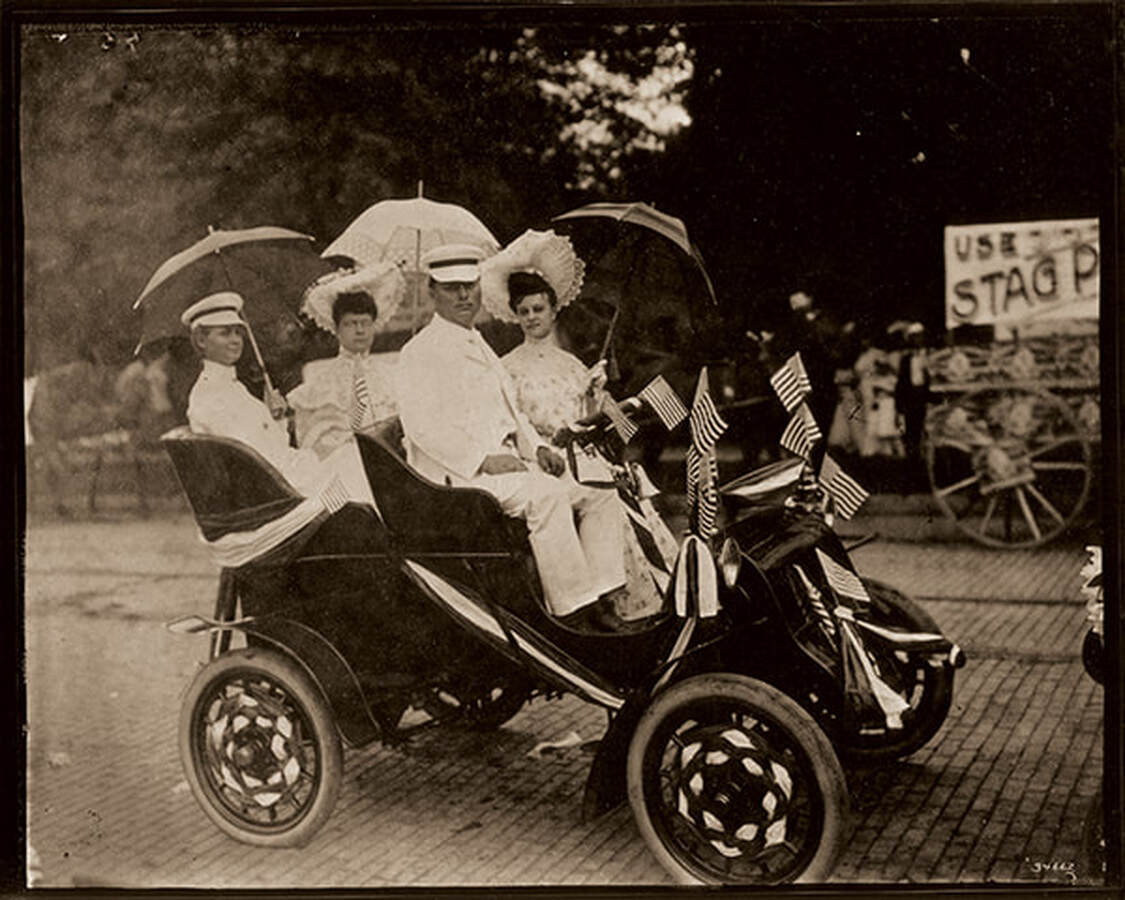|
Who was Gasparilla? The answer to that depends on who you ask. It is one of the first things people want to know when they come to our town for the annual Gasparilla Invasion and Festival. There have been many theories over the years, and someone back in time penned the following poetic explanation. Who was Gasparilla? Asks the stranger at our gate. Listen: then, and we'll the tale relate. Gasparilla was a pirate in the happy days of old. Who made a living off of other people's gold. He ravaged up and down this coast for many a bloody day. Finally, they hanged him down at Lemon Bay. There were a lot of pirates marauding around the seas in the 1700s, and José Gaspar could have very well been one of them. Because of the lack of evidence that he did exist, other people have decided that he is just a fictional character. Both camps are equally sure of their conclusion. It doesn't matter anymore. For those of you who haven't heard the stories, and there are several, here is one. A popular account portrays José Gaspar as a well-educated Spanish aristocrat and brilliant naval officer who turned into a swashbuckling buccaneer of the high seas when he became disenchanted with Spain in the 1770s. He was accused of stealing the crown jewels. When he jilted the daughter-in-law of King Charles III for a beautiful lady of the court, the scorned woman and accomplice stole the jewels and concocted the story accusing Gaspar. Hearing he was about to be arrested by the king and fueled by the desire for revenge, he stole a ship and sailed to Florida with a crew of escaped criminals. Finding life at sea desirable and wishing to continue his revenge on Spain, he wreaked havoc in the Gulf of Mexico. He seized many Spanish ships, robbing and burning them. The men and women who were crew and passengers were taken from the ships and murdered or made into enslaved people and concubines. Children and those, for other reasons, found undesirable were thrown overboard. Towns were seized, burned, and robbed. Once the ransom was paid, some of the captured rich were held for ransom and set free on one of the islands, such as Puerto Rico or Cuba. Eventually, Gasparilla, as he now called himself, made his headquarters around Gasparilla Island on the southwest Gulf coast of Florida. The history of José Gaspar explains another question people ask "When did it start?" The invasion by Ye Mystic Krewe started pretty much as just another event planned to give some carnival appeal to the fledgling but ambitious May Festival celebration in 1904. The first festival in May 1903 was named the May Music Festival because much of the agenda revolved around music in many forms. This second May Festival, a much more ambitious project, was to celebrate music, bowling and shooting events, military drill team displays, parades, a political rally, and a masquerade ball. The Tampa Bay Hotel's enthusiastic new manager, Mr. Thomas J. Laud-Brown, was very much involved in the planning. In one of his efforts to keep the faltering hotel profitable, he suggested the hotel as a location for the first convention to consider the benefits of building the Panama Canal. Mr. W. R. Fuller, President of the Tampa Board of Trade, liked the idea. Eventually, Governor W. S. Jennings issued invitations to all the Governors of the southern states to come or send delegates. Mayors from the south attended, including Tampa's Mayor James McKay. President Roosevelt was expected to send George B. Cortelyou, Secretary of the Department of Commerce and Labor, as his representative. The convention would be held starting May 4 in the Tampa Bay Hotel. The delegates would be staying at the hotel and honored at many of the festival's events. A political rally would also be a significant part of the event. It would be the last opportunity for candidates for various state offices to speak before the primaries were to be held later in May. The recently organized Rod and Gun Club promised competition from marksmen from around the state with prizes of $400.00 to be divided among the "crack shots" in the pigeon shoot. Up to 40 participants were expected. There would be running, trotting, and match races for equestrians, with entries from as far away as Jacksonville. The floral parade would be beautiful with all the city's men, women, and children dressed in their finest, riding in several–still novel–automobiles, on wagons and carts all decorated with flowers and streamers, and on horses in blankets made of flowers. They would leave from the Tampa Bay Hotel, then park and wind the streets alongside the military drill team and bands. The Grand Ball signaling the end of the glorious week would be a grand finale. It, too, would be held at the ballroom of the Tampa Bay Hotel. Yes, the festival would be much more than just music this year. Starting months in advance, the Tampa Morning Tribune announced plans and activities regularly. On April 5, the Morning Tribune announced the membership of society men being gathered to become a permanent carnival ball organization. The upcoming ball would feature a May Pole dance, and association members would be en masque and wearing magnificent velvet and silk costumes. It was to be a charming evening. The Morning Tribune announced the possibility of a mysterious invasion on April 23. A group of pirates was planning to come to town for the festival. The Morning Tribune published a proclamation announcing the first annual visit of Ye Mystic Krewe. The communication advised: "After a century of obscurity and retirement in this His Royal Majesty's dominion, it has been deemed suitable and desirable by His Royal Majesty that the Royal Court of Gasparilla shall once again, as of yore, visit our beloved friends in the fair and prosperous city of Tampa. Tis long ago since our gracious forefathers of honored memory held court in your beloved city, and mayhap in these many generations, our dear friends have become ignorant of the details of our Royal history." The proclamation went on to explain that of the ranks of pirates of long ago, thought dead of the Yellow Fever epidemic, a few escaped–including lineal descendants of Gasparilla who established a dominion in obscurity on a small island on Florida's southwest coast that they named Gasparilla in honor of their beloved Sovereign. We would be visited by the current Sovereign–"King Gasparilla the' Steenth." The letter was signed "GOSSIPPO Lord High Chamberlain; Guardian of the Pantry Key." Excitement was now growing as this latest announcement raced around the city. As time grew nearer to the festival, merchants got into the act, offering "May Festival prices" on some of the items suitable for the attendees of the various events. C.R. Pippin of 1008 Franklin St. had bargained for the ladies such as umbrellas with a "paragon frame, steel rod, and fancy handle" originally $1.25 on sale for 75 cents; walking hats in new shapes and styles, a $2.00 value for only $1.50. In a rallying effort for community support, one newspaper announcement urged, "Let every Tampa-ite have a glad hand and a cheerful smile this week." The Tampa Bay Hotel, which is now H. B. Plant Hall for the University of Tampa, was the center of most of the events, including the opening ceremonies, which were held on the grounds of the hotel at Tampa Bay Park. Tampa Mayor James McKay, President W.R. Fuller of the Board of Trade, President Vicente Guerra of el Centro Español, and other prominent citizens were on hand for the formalities. Mock Turtle Anglaise with Cucumbers, Pickles and chow-chow Fillets of Bluefish a la Bordelaise with Potatoes and Hollandaise Boiled Tongue Piquant Calves Head a la Vinaigrette, Spaghetti a la Alesmetane with Banana Fritters with Rum Sauce Prime Ribs of Western Beef, Drip Gravy Roast Philadelphia Capon with Currant Jelly Also offered were a variety of potatoes, rice, and string-less beans, and several desserts listed were Lemon Custard Pie, Cottage Pudding, Apple Pie, and Orange Ice. All are served with either coffee or tea. I can't help but wonder how many ordered the boiled tongue. We were told that Gasparilla and his entire crew would sail to Tampa and into the mouth of the Hillsborough River on their pirate ship, the Octopus, before daybreak on the day of the big parade, Wednesday, May 4. They would remain at a secret rendezvous site ashore until time for the big parade which was planned for that afternoon. Staying in hiding was prudent since the authorities wanted to question him about some of his more questionable activities on the raging seas. The parade was indeed a big fun event of the week. The Tampa Bay Hotel was still the center of attention since the parade would begin there. The hotel and grounds were groomed and decorated with buntings and streamers. Office buildings downtown festooned their doors with colorful buntings and flags. According to the Seventh Avenue Tribune Bureau, Ybor City made quite a showing. The flags of the U.S., Cuba, Spain, and Mexico were hung at the offices of Centro Asturiano. In the parade, Dr. Maximo Díaz entered his "little black Italian pony and diminutive phaeton," decorated with more flags, roses, and streamers. The Tampa Box Company had a two-horse delivery wagon filled with cigar boxes and covered in flags and streamers, "making a fine picture." The Reina Brothers also had two wagons decorated with the flags of the U.S., Germany, Cuba, and Spain. They only regretted that they couldn't find an Italian flag representing their country. Also, Ye Mystic Krewe arrived on this festive Wednesday, and the first invading masked pirates rode into town on horseback. The pirates proved as adept in the saddle as they were on the bucking, raging seas. It was also announced that trusted crew members would be roaming the city in search of the most attractive of the fair young ladies of the town and report back to their captain with the "comparative excellencies" of the maidens. After their introduction to the city at the parade, the pirate king and his crew would go back into hiding until Friday night when His Majesty and his crew would host the festival ball for all the prominent citizens of Tampa being held at the grand ballroom of the Tampa Bay hotel. When they arrived at the Festival Ball, they were attired in all their regal finery to announce the selection of the "Queen of the Festival" and her maids of honor. At a dramatic moment during the evening on the pirate king's command, silence would fall over the hall as all of Ye Mystic Krewe removed their masks to reveal their true identity. The first festival revealed the Pirate King as the Honorable Edward R. Gunby, a noted lawyer with aspirations for political office. The Queen of the Festival was declared to be Miss Mary Lee Douglass. The crown she wore was made especially for the event. It was beautifully bejeweled and had been sitting in the window of Kistenmacher's on view for the entire city to see in the days leading up to the event. The Queen also had a court of esteemed maidens revealed to be the Misses Woolridge, Carnes, Glenn, and Stevens. After all the ceremonies, they danced the night away until the music ended suddenly, and the pirates slipped away into the night to return to their ship and out to sea. In a moment of honor, Gasparilla left behind his Queen and her maids, as well as all the jewels and gold of the city. That is likely the reason he has been welcomed back to town almost every year since. The Gasparilla Invasion was a huge success. Unfortunately, the May Festival, as ambitious and grand as it was, didn't last. That was its last year. The following year the Gasparilla Festival moved to the fall to coincide with the fair, and later, as an event on its own, it moved to February. It wasn't until 1911 that the invasion came by sea for the first time when the pirates sailed into Tampa Bay. The invasion and parade were held on Mondays for many years, and it was a local holiday for many. Schoolchildren had the day off, and most downtown offices closed to celebrate the festival. The official holiday eventually faded, and in 1988 the festival moved to Saturdays. Since businesses and schools were no longer allowed the holiday, it was decided that more people could attend if the festival were held on Saturday. Over time the sailing crews have grown in numbers and size. Now a new year, 2006, is upon us, and rumor has it the pirate ships have been seen making their way toward Tampa. They were planning another invasion on January 28, 2006, so prepare your pirate gear. Come on down to the bay and be ready to be entertained. CIGAR CITY MAGAZINE- JANUARY/FEBRUARY 2006 Art & Photography Contributors: Hillsborough County Public Library, Tampa Bay History Center, The Florida State Archives, The Tampa Tribune/Tampa Bay Times, University of South Florida Department of Special Collections, Ybor City Museum Society, private collections and/or writer. GAIL ELLISGail Ellis attended the University of South Florida, lived and worked in Tampa for 40 years. Devoting her time to writing now, she currently resides in New Port Richey, Florida. She told us the following, “Just so you know, you cannot get decent Cuban bread nor a cup of café con leche in Pasco County.” FOLLOW CIGAR CITY MAGAZINE
0 Comments
Your comment will be posted after it is approved.
Leave a Reply. |
Archives
June 2013
Categories
All
|
Cigar City is a Florida trademark and cannot be used without the written permission of its owner. Please contact [email protected]
© 2021 Cigar City Magazine. ALL RIGHTS RESERVED.
© 2021 Cigar City Magazine. ALL RIGHTS RESERVED.






 RSS Feed
RSS Feed